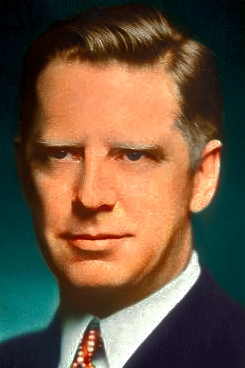
After Truman wins –
Move toward unity made by Democrats
CIO, South, bosses rally behind ticket
By Lyle C. Wilson, United Press staff writer
Chicago, Illinois –
President Franklin D. Roosevelt was off today on his fourth-term campaign with running mate No. 3 after a bruising final session of the Democratic National Convention which rejected Vice President Henry A. Wallace and nominated Senator Harry S. Truman (D-MO) for his job.
Mr. Roosevelt’s first running mate was John Nance Garner of Texas, who was elected Vice President in 1932 and 1936 and then broke with the President.
The Democratic nominees plan a late campaign, conforming to Mr. Roosevelt’s standard and effective practice. Neither is expected to begin major speeches until late September or October.
Senator Truman appears to have been the handpicked choice of the President, whose wishes were carried out here by a strategy board consisting of half a dozen men. Top honors for beating down the effort of left-wingers and others to keep Mr. Wallace on the ticket goes to National Committee Chairman Robert E. Hannegan, a 40-year-old from St. Louis who was chosen by Mr. Roosevelt to administer party affairs.
Senator Truman, nominated yesterday for Vice President about 24 hours after Mr. Roosevelt was named for a fourth term, is a second term member of the Senate who is chairman of the committee investigating munitions production and contracts. He is reckoned to have saved for the taxpayers a great many millions of dollars which might have been spent to no purpose.
Mr. Wallace was ahead on the first ballot, 429½ to 319½.
Stampede gets started
The remainder of the votes were scattered among other candidates, most of whom had been nominated to provide various state delegations with safe places to cast their votes pending some indication who might be the winner.
The Wallace drive began collapsing on the second ballot when little Delaware switched to give its full eight votes to Senator Truman. When Maryland was reached on the roll call, the delegation abandoned favorite-son Governor Herbert R. O’Conor to give Senator Truman 18 more votes.
Oklahoma Governor Robert S. Kerr then withdrew from the race and the state’s 22 votes went to Senator Truman. Virginia switched her 24 from Senator John R. Bankhead (D-AL) to the Missourian. By that time, the stampede was on and states were clamoring for a chance to change their votes.
A close contest
But even with the changes effected during the roll call, Senator Truman and Mr. Wallace were only three and a half votes apart when the last delegate was polled and before changes began being made for the record. Senator Truman had 477½ votes at the end of the roll call and Mr. Wallace had 473. Eleven other candidates were still in the contest at that time, but not for long.
By the time all the changes had been announced, the score, subject to minor correction, was:
| Truman | 1074 |
| Wallace | 66 |
| Cooper | 26 |
| Douglas | 4 |
| Absent | 6 |
Only 589 votes were required for a bare nominating majority.
Behind those figures is a story of angry disputes which foretells trouble for the New Deal-Democratic coalition. The strain of conflicting interests was evidenced in bitter language and boos in the convention yesterday.
Goes back four years
The story goes back to four years ago in the same stadium when Mr. Roosevelt compelled the sullenly reluctant 1940 Democratic Convention to accept Mr. Wallace as its vice-presidential nominee. That compulsion angered the south but was made effective with the support of the big northern Democratic organizations controlled by Chicago Mayor Edward J. Kelly, Jersey City Mayor Frank Hague, Pennsylvania’s David Lawrence, and others.
This year, the big organization leaders balked. On the advice of his associates or under their pressure, Mr. Roosevelt failed this time to insist on Mr. Wallace.
He said he would vote for him if he were a delegate. But he also advised National Committee Chairman Robert E. Hannegan that he would welcome either Mr. Truman or Mr. Douglas on the ticket, explaining that he thought either would add strength.
A bitter session
It was a bitter session beginning at noon and ending at 8:21 p.m. CT. The moment the results were announced most of the principals began to move again toward unity, especially Sidney Hillman of the CIO. Mr. Wallace and Mr. Hillman both sent congratulatory messages to Senator Truman.
The rebellious South will go along with Senator Truman – a factor which makes persuasive the argument that the Missouri Senator was the man Mr. Roosevelt wanted from the first, despite his letter saying he would vote for Mr. Wallace. Much of the South was bitterly opposed to Mr. Wallace. Party members from that region expressed fears here that organized labor, notably the CIO, might take over the party if Mr. Wallace were renominated. They wanted a Southerner for Vice President but compromised on Senator Truman because he could lick the Vice President here with Mr. Roosevelt’s support.
So, it will be President Roosevelt and Senator Truman against Tom Dewey and John Bricker this November. Mr. Roosevelt is 62 and Mr. Truman is 60. Governor Dewey is 42 and Governor Bricker is 50.


